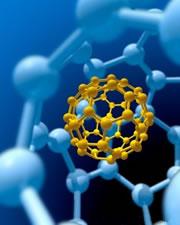 Balls of carbon have a talent for mopping up reactive oxygen species.VICTOR HABBICK VISIONS / SCIENCE PHOTO LIBRARY
Balls of carbon have a talent for mopping up reactive oxygen species.VICTOR HABBICK VISIONS / SCIENCE PHOTO LIBRARYSoccer ball-shaped nanoparticles known as buckyballs may one day help to offer relief for allergy sufferers. Adapted buckyballs are capable of blocking the pathway mediating allergic responses in human immune cells, research has revealed.
Buckminsterfullerenes — spherical cages about 1-10 nanometres in size made up of 60 carbon atoms — have for years attracted interest from material scientists for their ability to make strong, lightweight materials with interesting electrical properties. But they could have medical uses too.
It is known that buckyballs have a talent for mopping up reactive oxygen species called 'free radicals', which can play havoc with biological systems. "C60 has a very high electron affinity. It grabs electrons easily, so it can act to neutralise free radicals," explains James Cross, a chemist researching fullerenes at Yale University in New Haven, Connecticut. Previous studies have shown that buckyballs can be used to protect nerve cells, for example, from damaging oxygen species1.
Chris Kepley, an immunologist at Virginia Commonwealth University in Richmond, wondered if the carbon balls could also help out the immune system.
Shock reaction
Kepley's team, working with the Virginia-based nanomaterials company Luna Innovations, tested modified versions of the nanospheres in human cells and mice. Although the specifics of their formulations remain, for the moment, under wraps, they say they were able to enhance the fullerenes' functionality by adding side groups that increase their solubility. While some studies have hinted that buckyballs might be toxic, these modified versions have no apparent ill effects, says Kepley.
The group put human immune cells called mast cells in a dish — some with buckyballs, and some without — and then challenged them with a particle that is commonly used to mimic allergens such as pollen. Those with buckyballs released 50 times less histamine, one of the chemicals responsible for inflammation and tightening of the airways in asthma, and inhibited 30-40 other mediators involved in the allergic response.
Mice injected with buckyballs also released far less histamine when presented with allergens, the team reports in the Journal of Immunology2. Untreated mice were more susceptible to a drop in body temperature associated with anaphylaxis, a rapid allergic response that can cause death in a matter of minutes.
Histamine isn't all there is to allergic reactions, cautions Brian Lipworth, an allergy specialist at the Perth Royal Infirmary in Scotland. But he adds he will be intrigued to see the results from clinical trials in humans. "It's potentially interesting," he says. "We'll have to wait to see what happens when these molecules are tested in human volunteers."
Down with oxygen
Exactly how the buckyballs prevent mast cells from releasing histamine is unclear. "It's not really known what causes the release of histamine," says Kepley. "We do know that the rise in reactive oxygen species parallels the release of histamine," he adds. So the team's theory is that mopping up those radicals with buckyballs could inhibit the allergic response.
Antioxidants in general are known to be helpful against allergic reactions, but they aren't considered to be a cure-all.
ADVERTISEMENT
The whole idea of using nanoparticles to tackle allergy is a "completely new approach", says Clifford Bassett, a clinical immunologist with the American Academy of Allergy, Asthma and Immunology in New York. "Nanoimmunology didn't even exist until a few years ago," he says.
Kepley is confident their research will yield therapeutic results for a broad range of allergic and autoimmune conditions, including arthritis. He is currently in the process of securing funds for clinical trials in humans to see if buckyballs can control the symptoms of a range of conditions including hay fever, asthma and multiple sclerosis.
Visit our couldhelpfightal.html">newsblog to read and post comments about this story.
